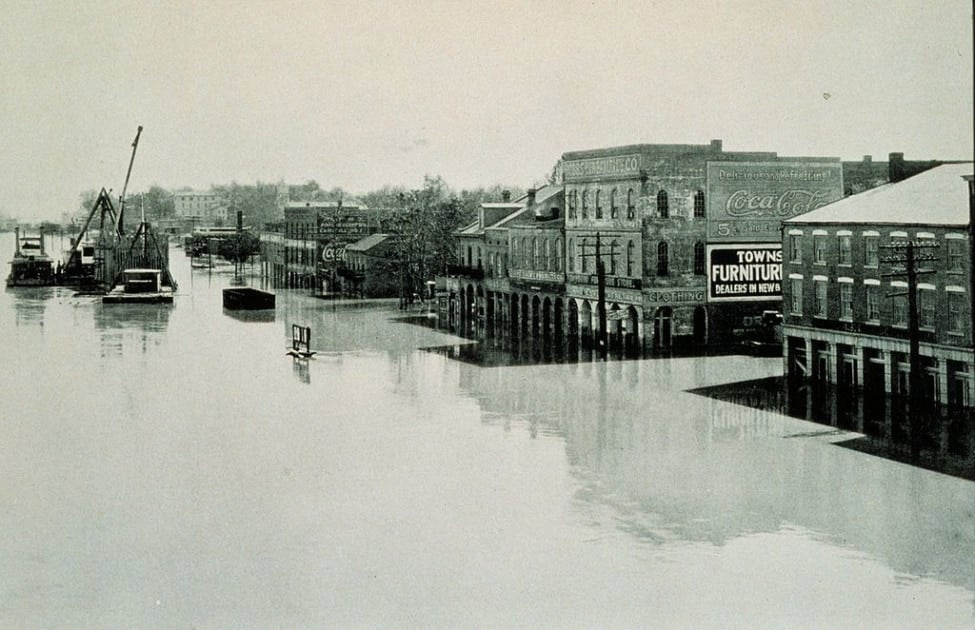High Water: The Great Flood of ’27
The Farmers’ Almanac turns its focus on one of the most devastating floods in United States history.

“If it keeps on raining,
The levee’s going to break.
When the levee breaks,
Got no place to stay.
All last night,
Sat on the levee and moaned.
Thinkin’ ‘bout my baby
And my happy home.”
from When the Levee Breaks
by Kansas Joe McCoy and Memphis Minnie
The Great Mississippi Flood of 1927 has been described as the most destructive river flood in the history of the United States. Though the 1993 Mississippi and Missouri flood rivaled, and even surpassed, it in many respects, the ’27 flood was notable not only for its sheer destructive force, but also because of the mark it left on American culture.
The seeds of the flood were planted during the summer of 1926, when a season of unusually heavy rains swelled the Mississippi’s tributaries in Kansas and Iowa. The situation didn’t abate over the course of the autumn, and on New Year’s Day of 1927, the Cumberland River reached 56.2 feet at Nashville, a record height to this day, and began spilling over the levees.
The situation continued into the spring, and soon the flooding spread throughout the river system, as levees throughout the region began bursting from the sheer volume of water.
One breach, in particular, inundated the area surrounding Mounds, Miss., with a deluge that more than doubled the volume of Niagara Falls. When the Mounds Landing levee ruptured on April 21, water covered an area 50 miles wide and 100 miles long. The floodwaters were up to 30 feet deep in places! By the time May rolled around, the Mississippi River was 60 miles wide below Memphis, Tenn.
In some areas, levees in smaller communities upstream of major cities were destroyed in order to spare the larger population centers. This happened in Louisiana, where, on April 29, officials blew up the levee at Caernarvon, north of New Orleans, flooding much of the parishes of St. Bernard and Plaquemines. This decision was controversial because none of the residents of those, largely poor, parishes were ever compensated for their property loss. In addition, the move later proved to be unnecessary, as other levee breaches farther north would have lowered the water in New Orleans before they topped the levees there.
Before it was over, the ‘27 flood had swept through 10 states: Arkansas, Illinois, Kentucky, Louisiana, Mississippi, Missouri, Tennessee, Texas, Oklahoma and Kansas.
Thousands of people throughout the region were left homeless and jobless, as the floodwaters covered their homes, farms, factories, and more. In response, the government created relief camps where people displaced by the flood could live. Conditions in these camps were rough, though,and often brutal, especially for the large number of African Americans who inhabited them.
The flood was, in large part, responsible for the Great Migration of African Americans from the rural south to urban centers in the north, such as Chicago, New York, and Detroit. This was spurred by the loss of the farmland where many had made a living sharecropping, coupled with the racist treatment in the relief camps, and during the flood itself, when rescue efforts focused on whites and left black people behind to fend for themselves.
A large body of music, primarily blues, also grew out of the ‘27 flood. Some of the most famous examples include Lonnie Johnson’s Broken Levee Blues, Charlie Patton’s High Water Everywhere, and Kansas Joe McCoy and Memphis Minnie’s When the Levee Breaks. Even today, artists as diverse as Randy Newman, Bob Dylan, and Led Zeppelin have performed songs that commemorate the Great Flood of 1927.

Jaime McLeod
Jaime McLeod is a longtime journalist who has written for a wide variety of newspapers, magazines, and websites, including MTV.com. She enjoys the outdoors, growing and eating organic food, and is interested in all aspects of natural wellness.






I live about 10 miles from the river,as the crow flies,east of the Sunshine Bridge.I remember my grandfather talking of the ’27 flood.The old family homestead has a bayou that once was fed off the Mississippi River.Even with this being near or reaching record highs,I have faith in our levee system.And when this is over we will have seen our weakness’s and take care of those areas.
My grandfather lived in Iuka, Mississippi.
My dad said that his father went west after the ’27 flood – and saw drowned mules in treetops. They had been swimming in the floodwaters – when their feet became tangled in branches – and they drown.
Thanks for sharing the above article with us. I happen to live in south central La. We are very concern about the flooding of today. I live but a couple of miles from the basin where they are releasing flood waters to . I have friends and relatives that are displaced today. I have one levee between my home and the basin. I sure hope it holds.